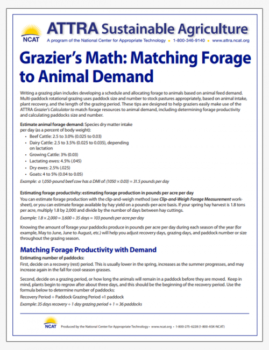Grazier’s Math: Matching Forage to Animal Demand
By Lee Rinehart, NCAT Agriculture Specialist
Overview
Writing a grazing plan includes developing a schedule and allocating forage to animals based on animal feed demand. Multi-paddock rotational grazing uses paddock size and number to stock pastures appropriately, based on animal intake,
plant recovery, and the length of the grazing period. These tips are designed to help graziers easily make use of the ATTRA Grazier’s Calculator to match forage resources to animal demand, including determining forage productivity
and calculating paddocks size and number.
Estimate animal forage demand: Species dry matter intake per day (as a percent of body weight):
- Beef Cattle: 2.5 to 3.0% (0.025 to 0.03)
- Dairy Cattle: 2.5 to 3.5% (0.025 to 0.035), depending
on lactation - Growing Cattle: 3% (0.03)
- Lactating ewes: 4.5% (.045)
- Dry ewes: 2.5% (.025)
- Goats: 4 to 5% (0.04 to 0.05)
Example: a 1,050-pound beef cow has a DMI of: (1050 × 0.03) = 31.5 pounds per day
Estimating forage productivity: estimating forage production in pounds per acre per day
You can estimate forage production with the clip-and-weigh method (see Clip and Weigh Forage Yield Calculator), or you can estimate forage available by hay yield on a pounds-per-acre basis. If your spring hay harvest is 1.8 tons per acre, multiply 1.8 by 2,000 and divide by the number of days between hay cuttings.
Example: 1.8 × 2,000 = 3,600 ÷ 35 days = 103 pounds per acre per day
Knowing the amount of forage your paddocks produce in pounds per acre per day during each season of the year (for example, May to June, June to August, etc.) will help you adjust recovery days, grazing days, and paddock number or size
throughout the grazing season.
Matching Forage Productivity with Demand
Estimating number of paddocks:
First, decide on a recovery (rest) period. This is usually lower in the spring, increases as the summer progresses, and may increase again in the fall for cool-season grasses.
Second, decide on a grazing period, or how long the animals will remain in a paddock before they are moved. Keep in mind, plants begin to regrow after about three days, and this should be the beginning of the recovery period. Use the
formula below to determine number of paddocks:
Recovery Period ÷ Paddock Grazing Period +1 paddock
Example: 35 days recovery ÷ 1 day grazing period + 1 = 36 paddocks
Estimating paddock size:
Determine paddock size: This is a function of herd dry matter intake of forages (grazing unit demand) relative to forage production. To calculate, multiply the herd intake by days grazed and divide this by forage availability and a utilization
rate. Forage utilization is the estimated percentage of the forage sward that will actually be consumed by livestock. A good rule of thumb is 50% (or 0.5), but because intense rotational systems are more efficient, we can increase the
utilization to no more than 70% (.07). When using 70% utilization, it is essential to fully recover grasses before re-grazing. For a way to determine this, see Chapter 2 in the ATTRA video Intensive Grazing: One Farm’s Set-Up, at 3:40 minutes.
Example: Assume dry matter demand of forage for 100 cows is 39 pounds per head per day, and forage productivity is 3,600 pounds per acre per rotation.
3,900 pounds herd intake × 1 day grazing period
3,600 pounds dry matter forage × 0.5 utilization rate
So, in this scenario, 36 paddocks of 2.2 acres average will support 100 cows with a move every day, giving us a 35-day recovery period. The total acreage needed for this system is 79.2 acres.
Using the Grazier’s Calculator
The Grazier’s Calculator is an easy way to match forage production with animal demand. This spreadsheet will calculate, seasonally, the number of paddocks and average paddock size, total forage production, paddock residual, forage available
for grazing per paddock, and forage inventory vs. grazing demand, to tell you if your balance is adequate or deficient. If you choose to use this tool, the values you will need to enter are as follows:
- Grazing dates for each grazing season of the year (i.e., spring, summer, fall, winter)
- Total acres
- Forage production estimate in dry matter pounds per acre per day
- Recovery period in days
- Grazing period in days
- Animal demand in dry matter pounds per day
- Number of animals
- Grazing utilization (percent of forage that will be
consumed by the animals, leaving the rest as a residual for plant regrowth and soil organic matter)
Download the Excel spreadsheet Grazier’s Calculator.
How to use the calculator:
- Enter your values in the gray cells. The spreadsheet will calculate all other values.
- Use the forage-production and grazing-unit-demand calculators in Worksheet 1 to determine projected forage inventory and grazing-unit intake demand.
- Use Worksheet 2 to determine the projected stocking rate for each grazing period. Note that the calculator will calculate pounds of paddock residual. This is as important as the livestock you are feeding. Residual that is cycled
through the rhizosphere provides carbon and other nutrients for the soil microbes and ends up as plant-available nutrients. Microbes are essential to maintaining soil health, a functioning soil, and less input, such as
fertilizer and pesticides. - The calculator on Worksheet 2 will determine if the forage production or inventory is adequate to feed your livestock while maintaining a residual base to feed soil microbes.
Grazier’s Math: Matching Forage to Animal Demand
By Lee Rinehart, NCAT Agriculture Specialist
Published November 2017
©NCAT
IP552
This publication is produced by the National Center for Appropriate Technology through the ATTRA Sustainable Agriculture program, under a cooperative agreement with USDA Rural Development. ATTRA.NCAT.ORG.


